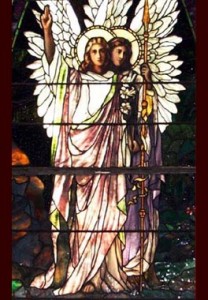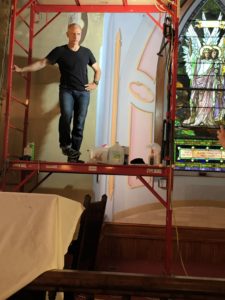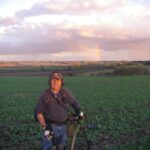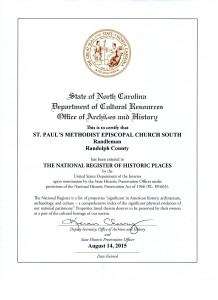 Founded in 1966, the North Randolph Historical Society seeks to ensure the preservation of St. Paul Methodist Episcopal Church and Randolph County’s rich history by collecting, preserving, exhibiting, and interpreting archival materials and physical artifacts associated not only with the history of northern Randolph County, but also with the larger Randolph County community. “Click” on “Activities“ for a listing of programs and when the museum will be open. Check out our gift shop, history page, and donate page. As always, we welcome your comments. (See “Contact Us” page)
Founded in 1966, the North Randolph Historical Society seeks to ensure the preservation of St. Paul Methodist Episcopal Church and Randolph County’s rich history by collecting, preserving, exhibiting, and interpreting archival materials and physical artifacts associated not only with the history of northern Randolph County, but also with the larger Randolph County community. “Click” on “Activities“ for a listing of programs and when the museum will be open. Check out our gift shop, history page, and donate page. As always, we welcome your comments. (See “Contact Us” page)
See The St. Paul Museum From the Air
Thanks to Steve Grogan for sharing his pictures of the St. Paul Museum from the air. “Click Here” to watch. Enjoy!
St. Paul Museum Monthly Programs 2025
The St. Paul Museum is closed January and February 2025. Doors for all programs open at 2:00pm and the program starts at 2:15pm.
April 27 – V-E Day and the 716th Railway Operating Battalion
May 18 – Revolutionary War in Randolph Co.
June 22 – Randolph County Civil Unrest During the Civil War – Don Farlow
With more than 98% of the eligible voters in Randolph County casting their votes in opposition to North Carolina holding a secession convention following the withdrawal of seven Southern states from the Union, and more than 90% of the voters in the region from Montgomery County to Wilkes County expressing their opposition, the voters of North Carolina had decided there would not be a secession convention to even consider withdrawing from the Union.
July 20 – 1st County Seat near Browns Crossroad
August 17 – Early Textiles
September 21 – Textile Museum
October 19 – Indigenous People in our Area
November 16 – Honoring Our Veterans (See Below)
In what is often described as “true military fashion; hurry up and wait,” Don Farlow will share about the compressed basic and technical training of his father’s U. S. Army Railway Operating Battalion, only to have to delay departure for Europe until sufficient advancement of Allied troops permitted restoration of railways to support the advancing front.
December 7 – Christmas Program
St. Paul Restoration Project
 One of the goals of the North Randolph Historical Society is to not only preserve the church but to restore it to its former glory. Jule Gilmer Körner (Ruben Rink), a well-known North Carolina artist of the day, painted the walls of the sanctuary with beautiful and airy designs of draperies, columns, the 10 commandments, and the Lord’s Prayer. The North Randolph Historical Society wants to restore the beauty of these paintings so we have hired Mr. Andrew Compton, an architectural paint conservator, who has worked at the U.S. Capitol and at George Washington’s home at Mount Vernon. Mr. Compton has finished restoring the apse of the church and has started restoration of the walls on either side of the apse. He has discovered 22K gold leaf under many layers of paint and in the video presentation of Mr. Compton’s work, you will note the dramatic difference where he has restored a small area surrounding one of the painted columns on the wall. (NOTE: Because of the size of the church, the lighting for this video was a “challenge”.) Click “Here” for the video.
One of the goals of the North Randolph Historical Society is to not only preserve the church but to restore it to its former glory. Jule Gilmer Körner (Ruben Rink), a well-known North Carolina artist of the day, painted the walls of the sanctuary with beautiful and airy designs of draperies, columns, the 10 commandments, and the Lord’s Prayer. The North Randolph Historical Society wants to restore the beauty of these paintings so we have hired Mr. Andrew Compton, an architectural paint conservator, who has worked at the U.S. Capitol and at George Washington’s home at Mount Vernon. Mr. Compton has finished restoring the apse of the church and has started restoration of the walls on either side of the apse. He has discovered 22K gold leaf under many layers of paint and in the video presentation of Mr. Compton’s work, you will note the dramatic difference where he has restored a small area surrounding one of the painted columns on the wall. (NOTE: Because of the size of the church, the lighting for this video was a “challenge”.) Click “Here” for the video.
Donations are needed to help us finish this goal. Please see the “Donate” page if you wish to contribute.
Eagle Scout Project Surveys St. Paul Cemetery
In November 2018, Randleman High School student, Connor Uehlein presented his Eagle Scout project that documented, mapped, and photographed the entire St. Paul cemetery with special emphasis on the graves of the Veterans. (Click “Here” for a link to his PowerPoint presentation.) Some highlights of his project include:
- 671 grave markers were identified.
- Birth dates ranged from 1762 to 2009.
- Death dates ranged from 1827 to 2016.
- There were 33 Veterans who honored America by serving in the Civil War, World War I, and World War II, Korea and Vietnam.
- There were a significant number of tragedies – with over 10% of the population dying before the age of 10.
- There was also some unexpected longevity, experienced in this time period, with about 7% of the people living to 90 years of age or better – including a few centenarians.
Attached is a listing (“Click” on the link below) of all burials at the St. Paul Cemetery as compiled by Connor who had assistance from Boy Scout Troop 531.
Listing of Saint Paul Cemetery November 2018 (Updated May 2019)
Also attached is a link to a “movie” (Click “Here“) which is a collection of photographs of all of the gravestones in the cemetery. Troop 531 worked over many many weekends in gathering this information. If you visit the museum, we have detailed information as to the exact location of each grave. Thanks to Connor, his parents and the scouts of Troop 531 for all of their hard work.
Metal Detecting, Archaeology and History in the UK
 An enthusiastic metal detectorist, and a member of the St. Paul Museum, John Steele, USAF, Ret., had always dreamed of metal detecting in England where humans lived, farmed, fought and died since the last Ice Age. He read many articles about discoveries dating from the Bronze Age, Roman, Anglo-Saxon, Viking, and Norman periods.
An enthusiastic metal detectorist, and a member of the St. Paul Museum, John Steele, USAF, Ret., had always dreamed of metal detecting in England where humans lived, farmed, fought and died since the last Ice Age. He read many articles about discoveries dating from the Bronze Age, Roman, Anglo-Saxon, Viking, and Norman periods.
In 2014, John received a wonderful birthday gift from his daughter—a two-week metal detecting tour in central England. The British Portable Antiquities Scheme (BPAS) encourages ordinary people who might find archaeological objects while metal detecting, gardening, walking, etc. to report their finds. Little did he know that he was about to discover a “nationally important artifact . . . [and] fantastic piece of local heritage for the county” according to the Buckinghamshire County Museum Trust.
John set out with Weekend Wanderers, a private tour group which had permission to metal detect at a farm site when numerous Roman coins had been found. On the second day of his trip, he picked up a signal for a large metal object; he dug down and saw the top of a bronze object.
Knowing that this was unusual, he called over the tour director who in turn contacted the local Finds Liaison Officer. That official alerted the county Archaeological Officer and an emergency excavation was authorized. Over the next three days, Oxford Archaeology (OA) specialists lifted a cremation box burial. Back at the OA lab, the staff cleaned and researched the items.
In the second century AD, wealthy Romans were cremated and buried with goods needed in the afterlife. This burial was unusually rich with numerous vessels of glass, bronze and ceramics; the highly decorated bronze jug was unlike any ever discovered in Britain. The ceramic vessels bore the inscription from a known pottery workshop in Gaul (France) so the grave could be securely dated. Organic material suggested that the occupant was female and an engraved red jasper gem depicting the Roman goddess of wisdom, Minerva, reinforced that hypothesis.
John and the landowner donated the burial to the Buckinghamshire County Museum in nearby Aylesbury. Funds in the amount of £3,000 (approximately US $4,500) were raised for Oxford Archaeology to conserve the metal objects and reassemble the ceramic and glass vessels.
St. Paul Museum Now Has a Facebook Page
 Come and visit us on our new Facebook page and keep up-to-date with all of our activities. You can find us at northrandolphhistoricalsociety or at St. Paul Museum
Come and visit us on our new Facebook page and keep up-to-date with all of our activities. You can find us at northrandolphhistoricalsociety or at St. Paul Museum
St. Paul Museum Studied by UNCG Department of Interior Architecture
A graduate class from the Department of Interior Architecture at the University of North Carolina at Greensboro, headed by Professor Jo Leimenstoll, M. Arch., visited the St. Paul Museum. The purpose of the visit was to study the museum through photographs, architectural plans and interior sections. The class also carried out a conditions assessment of the building. Furthermore, they created a digital rendering of the trompe l’oeil murals on the north wall to highlight the artwork of Jule Gilmer Körner and present what it may have looked like in its original state. This study also included a virtual 360° view of the sanctuary interior.
In the Conditions Assessment, it was noted that the overall deterioration of the interior of St. Paul’s Church is minimal, and is mostly caused by weathering and natural causes, due to lack of maintenance for an extended period of time. (Note that the building was abandoned from 1951 until 1966.) This has caused moisture to infiltrate the building, and cause damage to the plaster and paint on the walls and windows. Additionally, the building may have suffered from excessive weight on non-load bearing walls, contributing to the deterioration. Click on the link to view the Conditions Assessment. St. Paul’s Church Architectural Study
The class also completed a 360º virtual tour of the museum. (Click “Here”) (Note that this is not to scale, does not show the contents of the museum, and only the north wall is shown with the trompe l’oeil murals completed by Jule Körner.)
In addition to Professor Leimenstoll, we would also like to thank the following students for their hard work in this study: Christopher Ford, Isabel Leon Villasmil, Carolina Marty Matos, Jessica M. Ocasio, Mélia Soulier Parizel, and Christopher Vann,
St. Paul Now Listed on the National Register of Historic Places
 The St. Paul Museum is now registered in the National Register of Historic Places which is a list of properties that are significant in American history, architecture, archaeology and culture. We are proud of this recognition and thank the many people involved in this effort. (Click “here” for Asheboro Courier-Tribune article)
The St. Paul Museum is now registered in the National Register of Historic Places which is a list of properties that are significant in American history, architecture, archaeology and culture. We are proud of this recognition and thank the many people involved in this effort. (Click “here” for Asheboro Courier-Tribune article)
Pictures from the past
The St. Paul Museum recently received some pictures and we need your help if you can identify where they were photographed. You can view the pictures on our ‘Picture Gallery‘ page. If you are able to help, please send contact us as shown on the ‘Contact‘ page.
